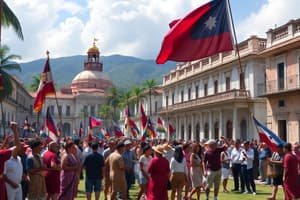Podcast
Questions and Answers
¿Cuál fue el líder de los conquistadores españoles que llegó a la región en 1513?
¿Cuál fue el líder de los conquistadores españoles que llegó a la región en 1513?
- Vasco Núñez de Balboa (correct)
- Fernando de Magallanes
- Francisco Pizarro
- Hernán Cortés
¿Cuál fue el impacto de la colonización en las poblaciones indígenas?
¿Cuál fue el impacto de la colonización en las poblaciones indígenas?
- Se produjo un aumento en la población indígena
- Muchos indígenas murieron debido a enfermedades y violencia (correct)
- Se establecieron relaciones pacíficas entre españoles e indígenas
- Los indígenas se convirtieron en líderes de la colonización
¿Qué tipo de sistema de trabajo forzado se estableció en la región?
¿Qué tipo de sistema de trabajo forzado se estableció en la región?
- Esclavitud
- Aprendizaje
- Trabajo asalariado
- Encomiendas (correct)
¿Qué cultivos se introdujeron en la región durante la colonización?
¿Qué cultivos se introdujeron en la región durante la colonización?
¿Cuál fue el propósito de la Audiencia de Panamá?
¿Cuál fue el propósito de la Audiencia de Panamá?
¿Quiénes fueron los principales grupos indígenas que habitaban la región antes de la colonización?
¿Quiénes fueron los principales grupos indígenas que habitaban la región antes de la colonización?
¿Qué técnicas de minería introdujeron los españoles en la región?
¿Qué técnicas de minería introdujeron los españoles en la región?
¿Cuál fue el impacto de la minería en la economía de la región?
¿Cuál fue el impacto de la minería en la economía de la región?
¿Qué fue el Viceroyalty of New Granada?
¿Qué fue el Viceroyalty of New Granada?
¿Qué fue la Province of Veragua?
¿Qué fue la Province of Veragua?
Flashcards are hidden until you start studying
Study Notes
Spanish Colonization
- Conquest and Colonization (1500s-1600s)
- Spanish conquistadors, led by Vasco Núñez de Balboa, arrived in the region in 1513
- Colonization led to the decline of indigenous populations due to diseases, violence, and forced labor
- Establishment of the Province of Veragua, a Spanish colonial province
- Governance and Administration
- The region was governed by the Viceroyalty of Peru, then later by the Viceroyalty of New Granada
- The Spanish Crown established the Audiencia of Panama, a judicial and administrative body
Indigenous Peoples
- Pre-Columbian Era
- The region was inhabited by various indigenous groups, including the Ngäbe, Buglé, and Naso
- These groups had their own distinct languages, cultures, and traditional practices
- Impact of Colonization
- Many indigenous peoples died due to diseases brought by Europeans, to which they had no immunity
- Those who survived were forced to work in mines, on plantations, or in other forms of forced labor
- The Spanish colonizers imposed their own culture, language, and religion on the indigenous populations
Agricultural Development
- Crops and Livestock
- The region was suitable for growing crops like maize, beans, and squash
- The Spanish introduced new crops, such as sugarcane, coffee, and cacao
- Livestock, including cattle, pigs, and chickens, were also introduced
- Land Distribution and Labor
- The Spanish Crown granted land to colonizers, who then exploited indigenous labor
- Encomiendas, a system of forced labor, were established to manage indigenous workers
Mining Industry
- Gold and Silver Rush (1500s-1600s)
- The Spanish colonizers discovered gold and silver deposits in the region
- Mining activities led to the establishment of mining towns and the growth of the economy
- Mining Techniques and Labor
- The Spanish introduced new mining techniques, such as mercury amalgamation
- Indigenous peoples were forced to work in mines, often under harsh conditions
Studying That Suits You
Use AI to generate personalized quizzes and flashcards to suit your learning preferences.




